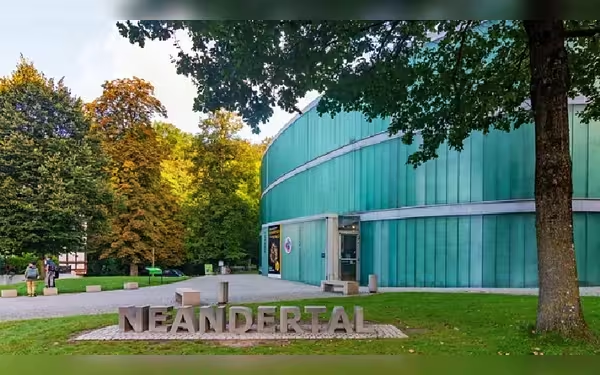Thursday, November 7, 2024 07:09 PM
Neanderthal Museum: A Window into Human Evolution in Germany
- Neanderthals share 4% DNA with modern humans.
- Museum attendance surged to 180,000 in 2023.
- Upcoming exhibit highlights women's roles in Neanderthal society.
 Image Credits: thefrontierpost
Image Credits: thefrontierpostExplore the Neanderthal Museum in Germany, showcasing our ancient relatives and their fascinating history.
In the heart of Germany’s Neander Valley, a region steeped in history, lies a museum dedicated to our ancient relatives, the Neanderthals. This area is famous for being the site where the first Neanderthal fossils were discovered in the 1850s. Today, the Neanderthal Museum serves as a bridge connecting us to our distant past, showcasing the fascinating journey of human evolution.
As visitors step into the museum, they are greeted by a life-like statue known as "Mr Four Percent." This figure, dressed in modern attire, represents the Neanderthal, a species that shares up to 4% of its DNA with many humans today. This striking resemblance highlights the fact that Neanderthals were not just primitive beings; they were complex and sophisticated in their own right. Recent studies suggest that instead of being wiped out by early humans, Neanderthals and Homo sapiens interbred, leading to the genetic connections we see today.
Located just 15 kilometers east of Düsseldorf, the museum offers an immersive experience that spans four million years of human history. With realistic models, Ice Age artifacts, and engaging exhibits, it invites visitors to explore the lives of our ancient cousins. Since the pandemic, interest in the museum has surged, with 180,000 visitors in 2023 alone, marking its highest attendance since its opening in 1996.
Despite their intriguing history, Neanderthals have often been misunderstood. Many people still view them as brutish cavemen, but the museum aims to change this perception. "From the very beginning, we understood it as our mission to rectify this image," said Bärbel Auffermann, the museum’s director. The museum has introduced new attractions, including a Stone Age-themed playground and a towering observation deck featuring a massive Neanderthal skull, which has garnered attention and accolades.
As our understanding of Neanderthals evolves, so does public interest. Recent documentaries, books, and studies have shed light on their lives, revealing that they were capable of creating tools, painting caves, and caring for one another, including individuals with disabilities. Author Rebecca Wragg Sykes, whose book "Kindred: Neanderthal Life, Love, Death and Art" has gained international acclaim, emphasizes the emotional connection many feel towards these ancient beings. She notes that the sequencing of the Neanderthal genome in 2010 changed the narrative, making them feel more relevant to our lives today.
As we delve deeper into the lives of Neanderthals, we discover that they were not so different from us. They had social structures, engaged in communal activities, and even had a sense of art and beauty. The museum’s upcoming exhibit, focusing on the role of women in Neanderthal society, promises to further enrich our understanding of these fascinating beings.
The Neanderthal Museum is not just a place to learn about our ancestors; it is a reminder of our shared history and the connections that bind us to those who came before us. As we continue to uncover the mysteries of human evolution, we gain valuable insights into our own identity and the intricate tapestry of life that has shaped humanity over the millennia. Visiting the museum is not merely an educational experience; it is a journey into the heart of what it means to be human.













